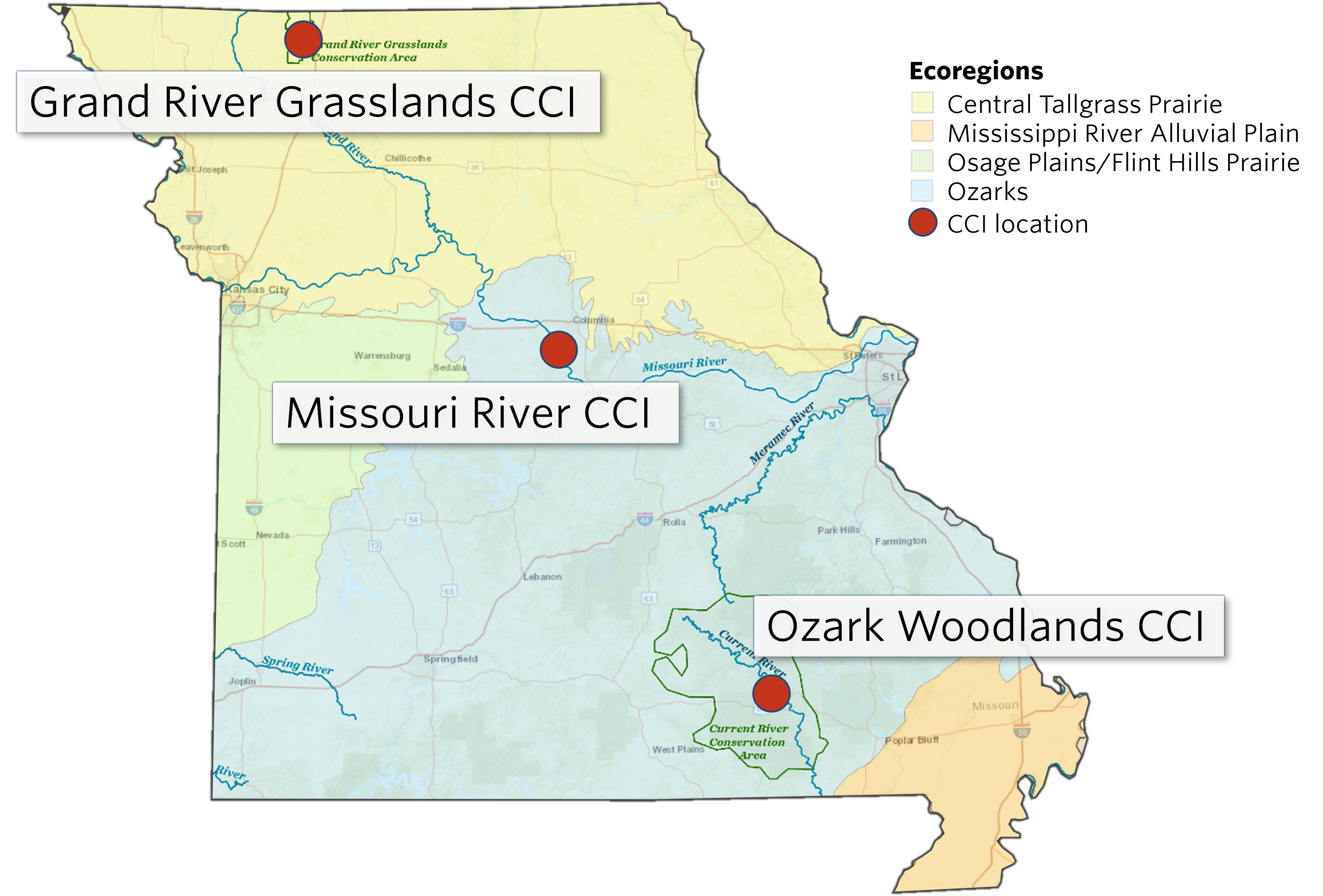Exploring Missouri's CCIs
Through our Centers for Conservation Innovation, TNC is advancing evidence-based collaborative conservation efforts across Missouri's diverse and iconic landscapes.

- Switch to:
- Overview
- Explore our CCIs
- Partners
Overview
The task of conserving Missouri’s lands and waters demands the coordination and collaboration of an extensive constellation of people and organizations scattered across the state. While cultivating meaningful partnerships is one of TNC’s greatest strengths, it remains a challenge to unify disparate actors, each with their own agendas, missions and challenges. Individually, each plays an essential role in stewarding the lands and waters crucial to Missouri’s future. But what if we could bring more of these stewards together to develop, prioritize and implement solutions at scale and in partnership? We are building a network of partners and preserves to cultivate the collective power of those working to protect our state’s natural resources.
To that end, TNC in Missouri is establishing Centers for Conservation Innovation (CCIs), which aim to serve as hubs for collaborative stewardship, scientific discovery, professional training and community engagement.
The centers help demonstrate land management practices, convene diverse partners and amplify new and existing conservation efforts in high-priority geographies across the state. The CCIs are strategically designed, managed and operated with relevant partners who can help us root the sites in the surrounding socio-ecological regions.
These centers are hubs that accommodate multiple uses. They are places where school children can visit to learn about nature, new generations of conservation practitioners earn experience in a growing industry and professionals can kick the tires on the latest sustainable practices to see what works before making their own investments.
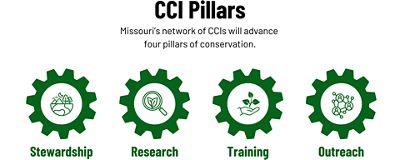
As a whole, our CCIs—modeled in part after a similar initiative by our colleagues in TNC Florida—aim to advance four pillars of conservation: stewardship, research, training and outreach.
Learn more about each pillar:
-
TNC collaboratively protects, maintains and enhances natural areas and native species’ populations across the globe. Through CCIs, we can better showcase that work in Missouri in concert with related outreach, education and science efforts.
Stewardship varies widely at each center, from tree planting and wetland restoration to prescribed fire and invasive species removal, but it is always place-based, partner- and learning-oriented, and scientifically informed.
-
At a time when humans are collectively grappling with major global biodiversity loss, a changing climate, shifting perceptions of nature’s importance and increasing demands for natural resources, the need for solutions-oriented field research has never been more urgent. Our CCIs serve as indispensable real-world laboratories where scientists can further our understanding of our planet’s living systems and advance the solutions needed to face today’s challenges.
TNC in Missouri leverages CCIs to advance our own research questions, and we also maintain an “open door” policy whereby we invite external researchers to use our lands and waters to fill critical knowledge gaps. Collaborative research at CCIs directly influences and expands our conservation knowledge and allows us to keep track of shifting baselines and long-term trends that may otherwise slip undetected.
Together, these investigations benefit nature and people across Missouri and beyond by shedding light on the ecosystem services nature offers and the most viable and scalable solutions toward a future where humans and nature can thrive.
-
The goal for conservation education and training at CCIs is to inspire and prepare conservation leaders through inclusive, engaging and challenging learning opportunities. CCI’s formal and informal education and training programs provide relevant learning opportunities for a variety of audiences including K-12, college students and natural resource professionals. Providing access to on-the-ground conservation training experiences—e.g., prescribed fire training exchanges (TREX)—for students and early career professionals balances the theory they learn in classrooms and helps ensure that our emerging conservationists are ready to face the challenges of the day. Likewise, training for seasoned professionals keeps them up to date with novel technologies and new, evidence-backed approaches. Our training events are also collaborative in nature, affording attendees opportunities to connect with partners, expand professional networks and learn from each other.
-
As the shifting climate and degraded living systems continue to impact everybody’s lives, it is more important than ever for people to understand the role that nature plays in our everyday lives. Through our partners and staff, we offer several ways for the public to get involved with place-based environmental educational programs and activities at our CCIs. Our CCIs aim to create an inclusive environment for people and communities that will inform and expand their awareness and appreciation of nature.
Outreach programs and activities—e.g., immersive Missouri River field trips or prairie plant identification walks—provide the public opportunities to connect with TNC and our partners to experience nature and to contribute to community-based conservation. These efforts foster a deeper understanding of the critical role that nature plays in our lives and stir up the inspiration to step up and speak up for nature.
Watch Our CCI Videos
Exploring Missouri's CCIs Learn about the importance of collaboration in conservation and how Missouri's CCIs in the Grand River Grasslands, mid-Missouri Riverland and the Ozarks are designed for partnership and innovation. See how these centers bring together partners across the state to amplify conservation efforts.
4:52
Related Videos
Exploring Missouri's CCIs
Now playing 4:52
Photos from our CCIs




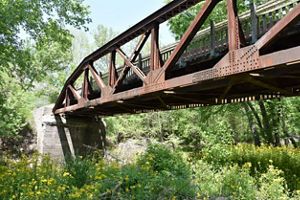






Missouri River CCI: The Missouri River Center for Conservation Innovation in Huntsdale, MO © Doyle Murphy/TNC

Bird Survey: Volunteers participate in a biodiversity inventory at TNC's Missouri River CCI © Doyle Murphy/TNC

CCI Volunteers: Volunteers gather to plant nearly 2,000 trees in the first of several plots at the Missouri River CCI. © Kristy Stoyer/TNC

Missouri River CCI: Turtles resting on a log in the Missouri River. © Doyle Murphy/TNC

Missouri River CCI: An old train bridge is now a connection for bicyclists over Terrapin Creek along the Katy Trail. © Doyle Murphy/TNC

Bison with calves: Bison from Dunn Ranch Prairie © Linda Gaulding

Missouri River CCI: The building formally used as The Station House at Katfish Katy's will be utilized for education and outreach at the Missouri River Center CCI. © Doyle Murphy/TNC

Ryan Cox & Kent Wamsley: Ryan and Kent at Little Creek Farm in Harrison County, MO © Kristy Stoyer/TNC

Missouri River CCI: Butterflies on the muddy riverbank of the Missouri River. © Doyle Murphy/TNC

Prairie Overlook: At Dunn Ranch Prairie in Missouri © Doyle Murphy/TNC
Explore Missouri’s Three CCIs
So far, we have established three CCIs in Missouri. Each is based at a different TNC preserve, located in distinct high-priority ecosystems. Each center is tailored to the surrounding region in consideration of the local needs, culture and opportunities.
Missouri’s CCIs
We have established three CCIs in Missouri. Each is based at a different TNC preserve, located in distinct types of high priority ecosystems.
Grand River Grasslands CCI: Located in the tallgrass prairie ecoregion of northwest Missouri
Missouri River CCI: Overlooking the Missouri River in Boone County
Ozark Woodlands CCI: Near Van Buren in southern Missouri
Ozark Woodlands
Located on The Nature Conservancy’s Mill Creek preserve, north of Van Buren, the property is a collection of oak and pine woodlands, glades, springs, fens and riparian forests on the border of the Ozark National Scenic Riverways.
The site features restoration of characteristic Ozark habitats, prescribed fire training opportunities and the potential for biodiversity and land management research.
Grand River Grasslands
Tallgrass prairie ecoregion of northwest Missouri, which encompasses TNC’s Dunn Ranch Prairie.
Conservation themes include prairie restoration, prescribed fire training, hydrological restoration, sustainable grazing, soil health, biodiversity research and bison restoration.
Missouri River Center
Overlooking the Missouri River in Boone County, this site aims to connect people to the Missouri River and explore regenerative agroforestry practices suitable for big river floodplains.
The center is a collaborative effort between TNC Missouri, Missouri River Relief and the University of Missouri Center for Agroforestry.
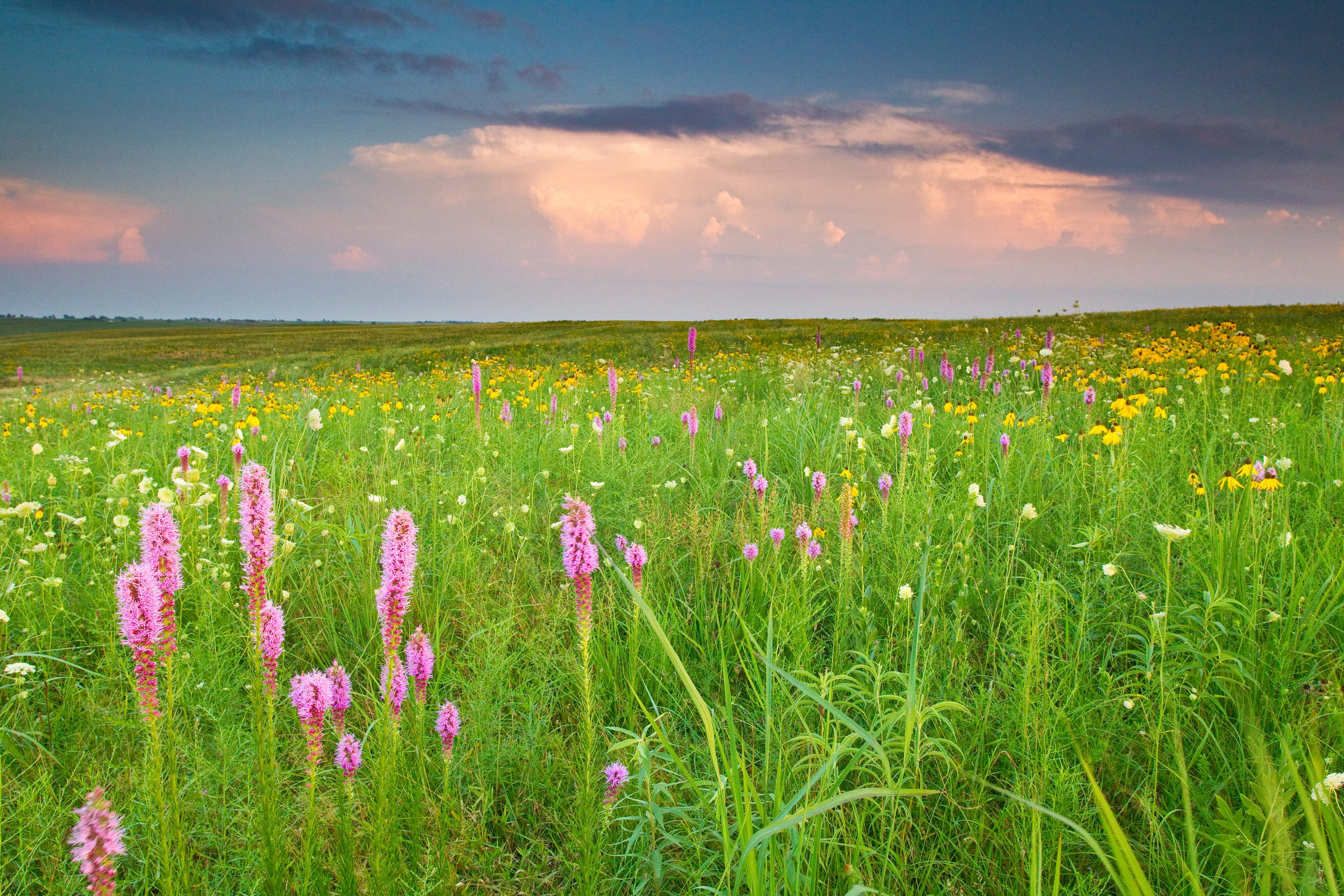
Grand River Grasslands
Headquartered at Dunn Ranch Prairie in northwest Missouri, the Grand River Grasslands CCI offers countless opportunities to learn from the flora, fauna and ecological processes that make up the iconic landscapes of the Great Plains. This tallgrass prairie preserve includes nearly 1,000 acres that have never been plowed, surrounded by another 2,000-plus acres of grasslands restored with native plants, prescribed fire and grazing.
Today, bison amble over the hillsides and valleys, a band of greater prairie-chickens stage mating season dances and wildflowers rise and retreat with the seasons. Less than 1% of Missouri’s grasslands remain today, making the Grand River Grasslands CCI crucial to our understanding of complex prairie ecosystems.
The southern boundary of Dunn Ranch Prairie includes Little Creek Farm, a working ranch, created as a demonstration of sustainable agriculture in collaboration with a local rancher. A renovated farmhouse onsite has meeting space and temporary lodging that we’ve used for a wide range of conservation activities, such as hosting prescribed fire crews, researchers, collaboration sessions with partners and cultural retreats of Tribal nations.
Stewardship: Conserving the lands and waters we all depend on is built into TNC’s mission. The CCI program carries that charge forward. The lessons learned on TNC’s preserves are meant to extend beyond our property boundaries. At the Grand River Grasslands CCI, dedicated staff follow science-backed conservation practices, such as using prescribed fire to control invasive plants and rejuvenate deep-rooted natives.
We collaborate with partners, including the Missouri Master Naturalists, to collect seeds from native plants that are then used to reseed our grasslands as well as those managed by others, such as the Missouri Department of Conservation. Other stewardship practices include excluding cattle from Little Creek and installing alternative watering systems to reduce the erosion that clogs streams and destroys aquatic habitat. In these lands, the bison reign as keystone species, reshaping the prairie through grazing and wallowing.
Research: Even before TNC in Missouri launched the CCIs program, Dunn Ranch Prairie was popular with visiting researchers interested in grasslands ecology, pollinators, prescribed fire, bison and countless other topics. Their work contributes to a better understanding of the grasslands at large and often helps us test and refine our conservation practices. Regular soil testing, native plant tracking on grazed and ungrazed plots, and annual data collections on bison are just a few examples of the research guiding us at Dunn Ranch Prairie.
The prairie is also a regular stop for observers tracking migrating birds and the annual trek of monarch butterflies across North America. In 2013, TNC and its partners in the Missouri Department of Conservation and U.S. Fish & Wildlife Service reintroduced the endangered Topeka shiner, a native of prairie streams. A later stream-restoration project reconnected about 5 miles of the minnow’s habitat in Little Creek, and there is ongoing research to study that, too.
Training: To safeguard the future of the lands and waters that are essential to the Great Plains, we must cultivate a workforce that understands these systems and the stewardship needed for long-term preservation. Developing the next generation of conservationists is critical to TNC’s mission and is reflected in our work at the site. For example, our partnership-based Habitat Strike Teams routinely travel to Dunn Ranch Prairie to train on controlled burns and other methods of stemming invasive plants. We host undergraduate fellows from Drake University annually to offer hands-on training in science and stewardship. And our flagship training event—which draws in attendees from across the U.S.—is a Fire Science Workshop for students, scientists and early career fire practitioners. We are also planning for new professional training opportunities related to conservation technologies and native seed harvesting.
Outreach: The Grand River Grasslands CCI is well positioned to connect people with nature. Dunn Ranch Prairie is TNC’s most popular preserve in Missouri. Tens of thousands of people have visited since 1999, when TNC bought the core of the site from descendants of the Dunn family. Guests are encouraged to take a self-guided tour, using a series of kiosks to learn about the tallgrass prairie, native plants, wildlife and restoration efforts. There are also scenic overlooks and an elevated platform that provides expansive views across the prairie. The half-mile Lordi Marker Nature Trail opened in 2023, winding through wildflowers, forbs and grasses characteristic of the ecosystem.
Every two years, we collaborate with the Missouri Department of Conservation and Missouri Master Naturalists to host Prairie Days at Dunn Ranch Prairie. (In alternate years, the event moves to TNC’s Wah’Kon-Tah Prairie near El Dorado Springs.) The event, which is our flagship public engagement opportunity at the site, includes tours of the preserve, a variety of exhibitions from conservation educators, and locally made bison burgers and other items for purchase. Past demonstrations have highlighted prairie reptiles, pollinators and plant identification.
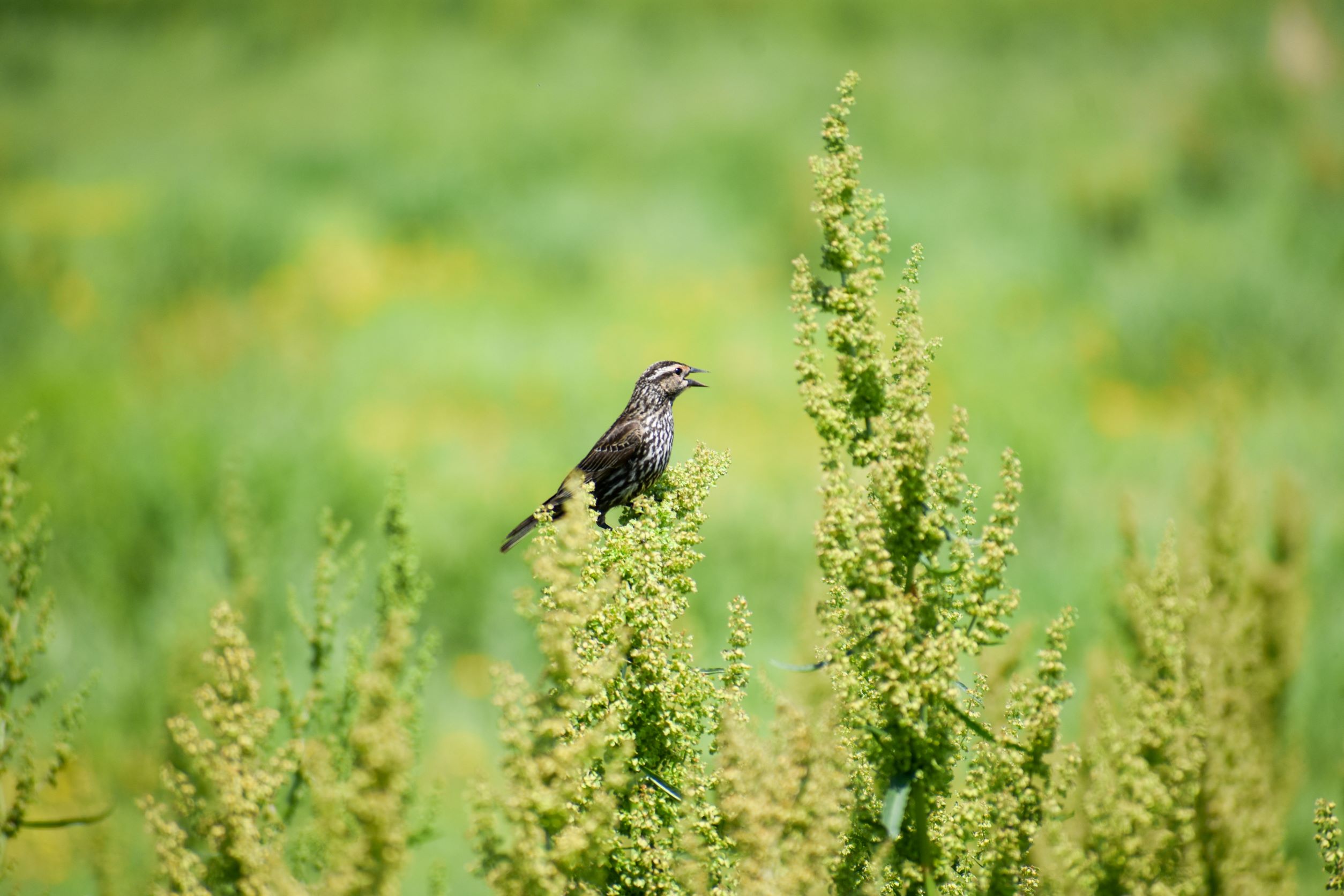
Missouri River Center
Located just 20 minutes southwest of Columbia, the Missouri River CCI spans 164 acres along the iconic Missouri River. The site will serve as a multi-use space allocating portions of the property to ecosystem restoration, public use, agricultural stewardship via agroforestry and educational programming built around the Missouri River.
The center is a collaborative effort between TNC Missouri, Missouri River Relief and the University of Missouri Center for Agroforestry. Missouri River Relief focuses on connecting people to the Missouri River through education, stewardship and recreation programs, while the Center for Agroforestry contributes to regenerative design, tree plantings and agroforestry-focused educational programming.
Stewardship: Stewardship is at the heart of the Missouri River Center's mission. The site is transitioning from annual row crops to a polyculture of native, flood-tolerant perennial trees and shrubs. Agroforestry has deep roots in floodplain ecosystems with trees like pecans, walnuts and other flood-tolerant natives. The center aims to serve as an agroforestry training and demonstration site for big river systems.
In the fall of 2024, we planted nearly 2,000 native trees at the site. More than 400 pecans and walnuts were planted in an alley cropping system on the northern side of the property. On the south side of the property, we are building out the riparian buffer with a diversity of plantings to showcase a variety of “menu options” that offer benefits to both farms and biodiversity. Innovative methods to combat the invasive Johnsongrass are being tested, including densely planting trees to create shade and using cover crops to disrupt its growth.
Other restoration efforts focus on wetland restoration and stabilizing eroding riverbanks. The center aims to foster not only enhanced stewardship but also a connection between the community of conservation practitioners and the Missouri River, underscoring its importance for preservation for future generations.
Research: The Missouri River Center aims to serve as a hub for research on agroforestry, floodplain stewardship and wetland restoration. One key area of focus is monitoring bird and bat activity using autonomous recording units along the site’s riparian corridor. This research aims to understand how increasing the width of and diversity of the riparian buffer impacts the site use by these species over time.
Additionally, soil health assessments are being carried out by the Soil Health Assessment Center at the University of Missouri. These assessments analyze microbial activity, organic matter and carbon content to establish a baseline for tracking changes as the site transitions from annual crops to perennial production.
Training: The Missouri River Center aims to serve as a field station for various educational and training programs associated with bottomland stewardship, including farm tours and conservation workshops. In collaboration with the University of Missouri Center for Agroforestry, the site has the potential to play a significant role in training the next generation of conservationists with opportunities related to wetland restoration and flood-tolerant regenerative agroforestry.
Outreach: The Missouri River Center is dedicated to connecting people with the history, beauty and ecology of the Missouri River. The center plans to host community events and educational programs in collaboration with Missouri River Relief, engaging thousands of students and teachers in hands-on learning experiences.
Additionally, plans are underway to create a public trail featuring informational signs and kiosks, providing visitors with insights into the area’s natural and ecological significance.
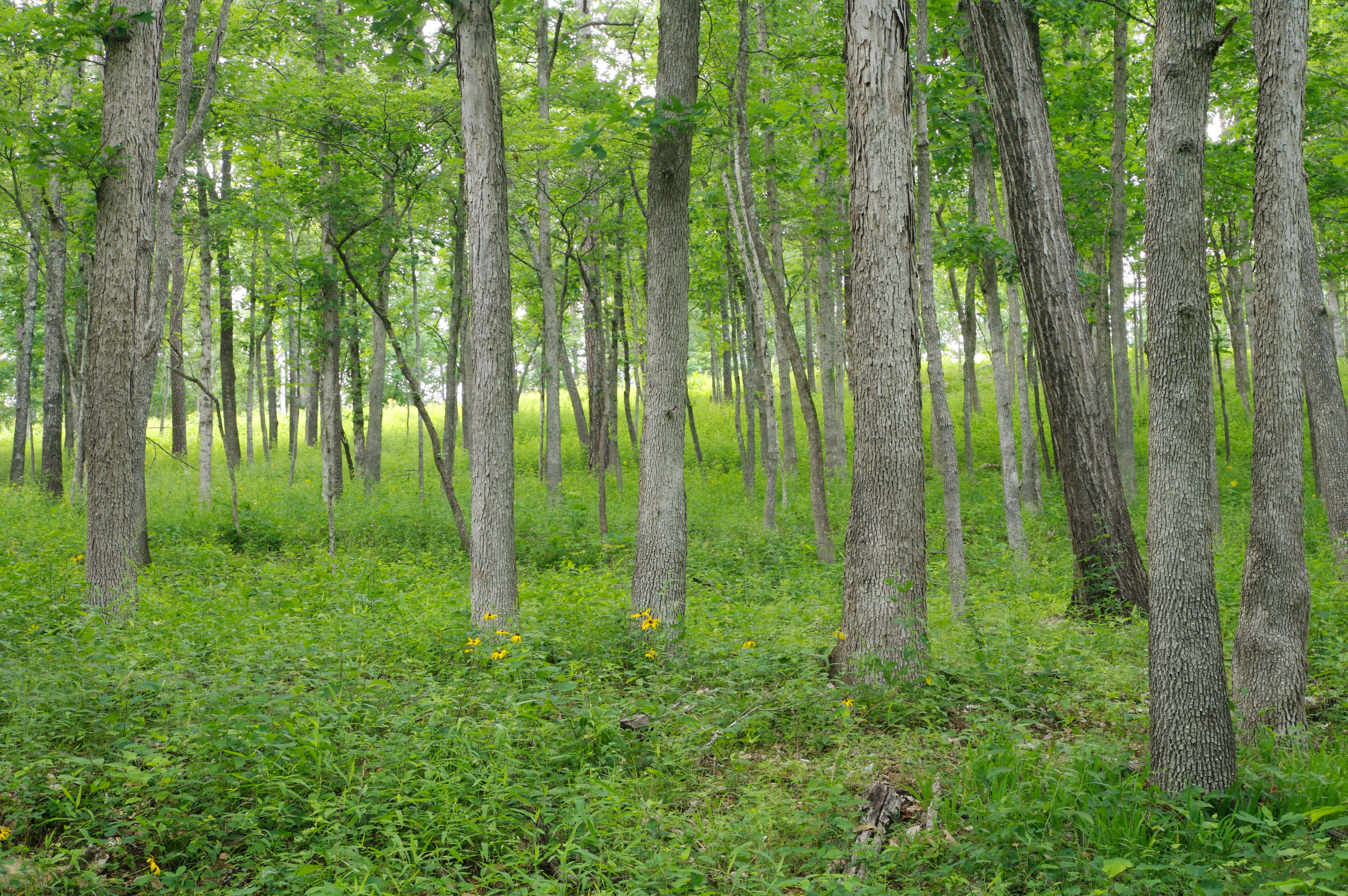
Ozark Woodlands
The Ozark Woodlands CCI packs the best parts of the Ozarks into its 163 acres. Located at TNC’s Mill Creek property near Van Buren in the Southeastern Ozarks, the area is a collection of oak and pine woodlands, glades, springs, fens and riparian forests on the border of the Ozark National Scenic Riverways. Large rock outcrops, small bluffs and even a shelter cave are found on site.
This project is uniquely positioned in a central location, making it highly accessible to key partners like the Missouri Department of Conservation (MDC). As with other TNC projects across the state, our collaboration with MDC, along with other partners, is crucial to the center’s success. Other collaborators in the region include the National Park Service, the L-A-D Foundation, U.S. Forest Service and the Missouri Department of Natural Resources.
TNC purchased the property in 2021. Like our first CCI at Dunn Ranch Prairie, the Ozark Woodlands CCI is a place where TNC will be able host researchers on site and contribute to the investigation, protection and stewardship of one of our state’s most important ecosystems. We are currently conducting a feasibility study for infrastructure development at the Ozark Woodlands CCI site that includes plans for a fire cache and bunk housing, shared between TNC and the Missouri Department for Conservation. We envision the center as a collaborative hub for improved stewardship across the Ozarks, working closely with MDC and other key partners.
Stewardship: TNC’s work here carries forward the previous owner’s long-term restoration goals. This includes efforts such as invasive species removal and prescribed burns to reopen glades, ensuring that native flora and fauna can thrive. Long-term stewardship plans are being developed to showcase a diversity of habitats, benefitting the site’s biodiversity, resilience and anticipated use as a space for place-based learning.
Research: Research is likely to be the cornerstone of the Ozark Woodlands CCI. Through our partnership with MDC, the center could serve as a key central hub for long-term research, notably the Missouri Ozark Forest Ecology Project (MOFEP). This 100-year ecology project focuses on the effects of various forest stewardship approaches on biodiversity, carbon sequestration and productivity.
TNC has long conducted and facilitated research on biodiversity, Ozark landscapes and the effects of prescribed fire in the region. The center neighbors TNC’s former Chilton Creek Research and Demonstration Area, which TNC transferred to the Missouri Department of Conservation in 2022, reconnecting it with surrounding conservation areas. The region offers access to unique wildlife and landscapes, including opportunities to build upon long-running research or pursue new questions.
Training: Training is crucial for equipping individuals with the skills needed to steward the Ozark woodlands effectively. Prescribed fire training is expected to be a major component of the Ozark Woodlands CCI. TNC is coordinating with partners on plans to expand facilities to accommodate fire teams and fill a critical resource gap. The center also has the potential to support educational initiatives and hands-on fieldwork for a new generation of researchers and conservation professionals.
Outreach: The center features a house with meeting space, making it a convenient place for the numerous conservation-minded organizations and agencies working in the region to gather and share information.
Due to geography, partners and regional priorities, outreach will likely be the least developed conservation pillar at the Ozark Woodlands CCI. Nevertheless, some outreach hosted by TNC and our partners will take place on site. These activities will likely include periodic guided visits such as site tours and wildflower walks.
Partners and Collaborators
CCIs build upon our long-term experience and existing partnerships across Missouri to greatly expand and focus the amount of education and training, outreach and research that TNC influences.
Missouri Department of Conservation (MDC)
Missouri Department of Natural Resources (MDNR)
Missouri Prescribed Fire Council
Missouri River Bird Observatory
Natural Resources Conservation Service (NRCS)
Oak Woodlands and Forests Fire Consortium
University of Missouri Center for Agroforestry
University of Missouri Center for Regenerative Agriculture

Sign up for Nature News
Get conservation stories, news and local opportunities from where you live.
